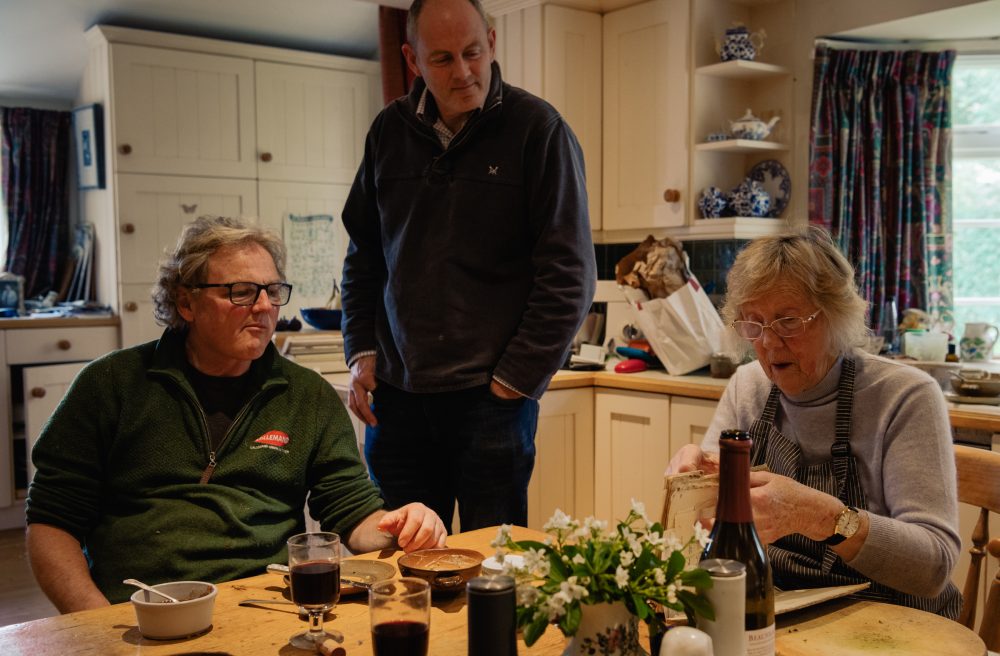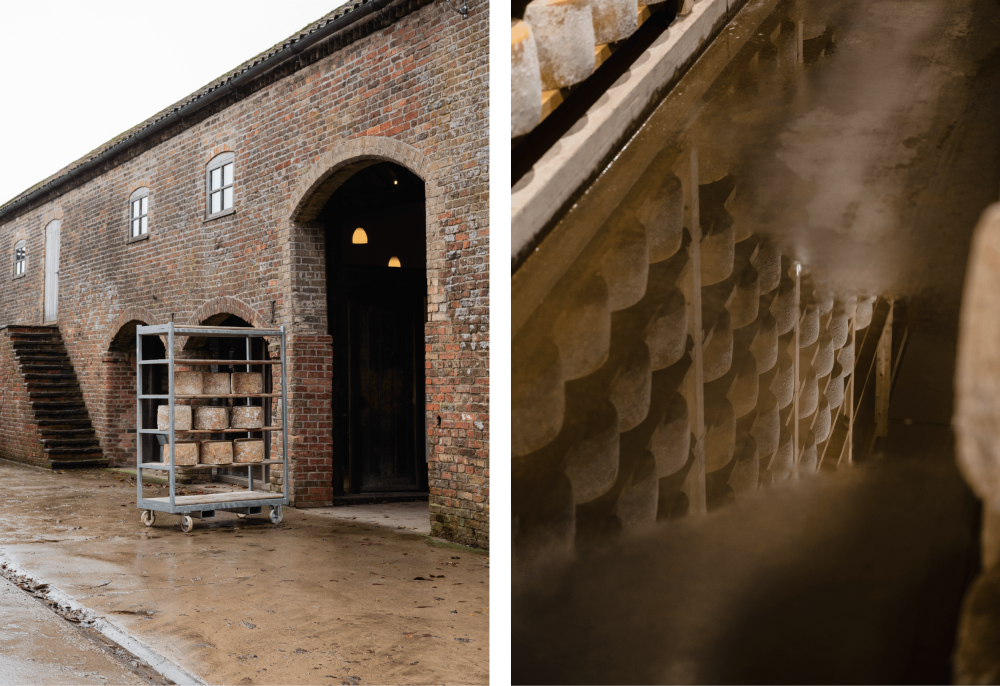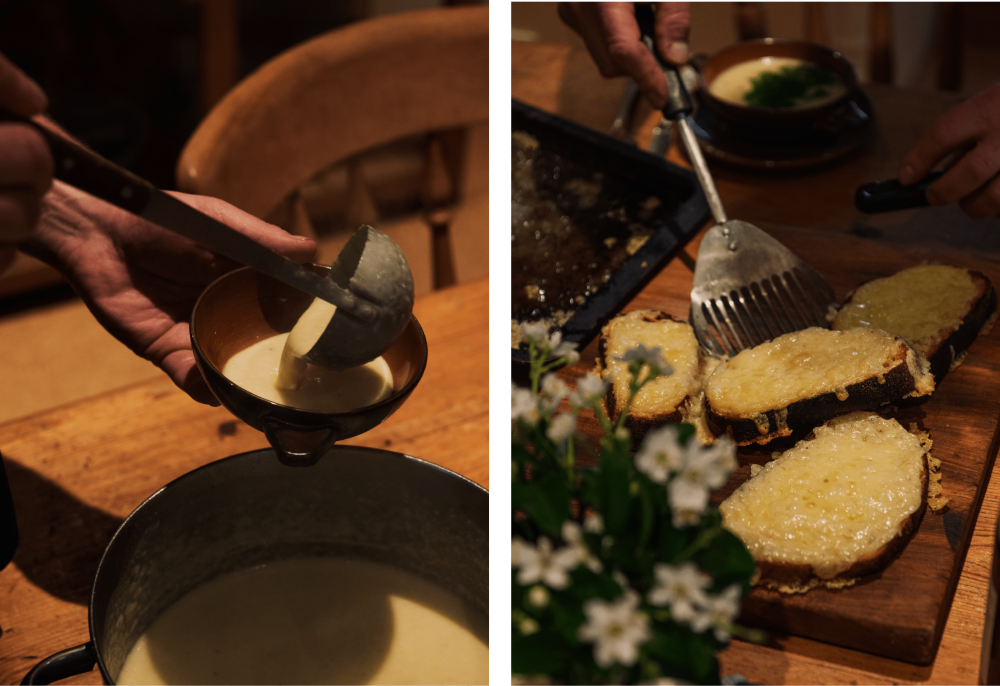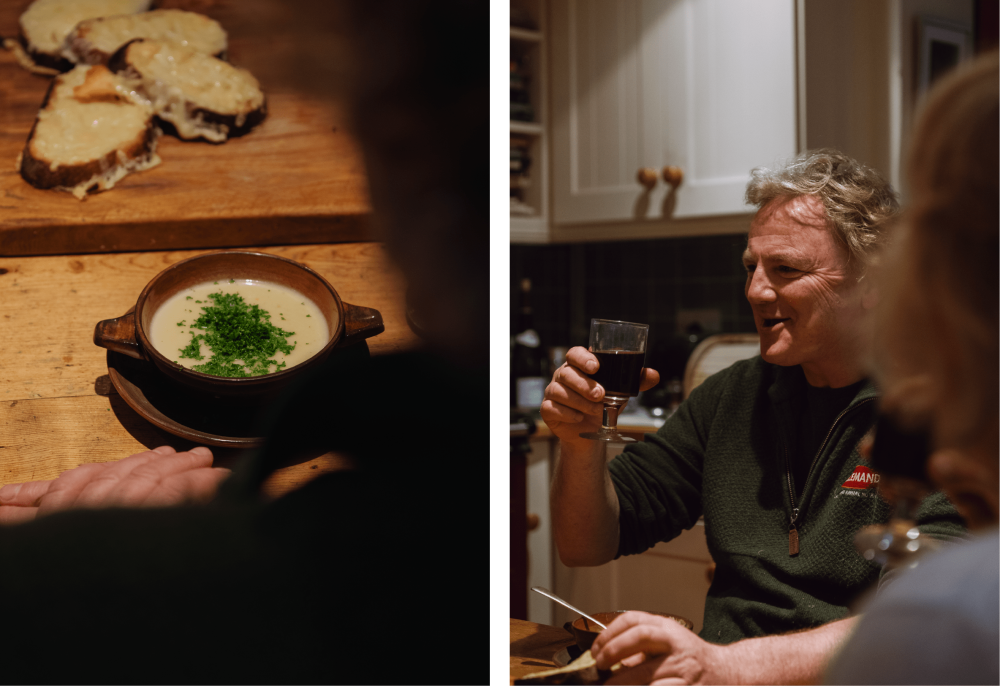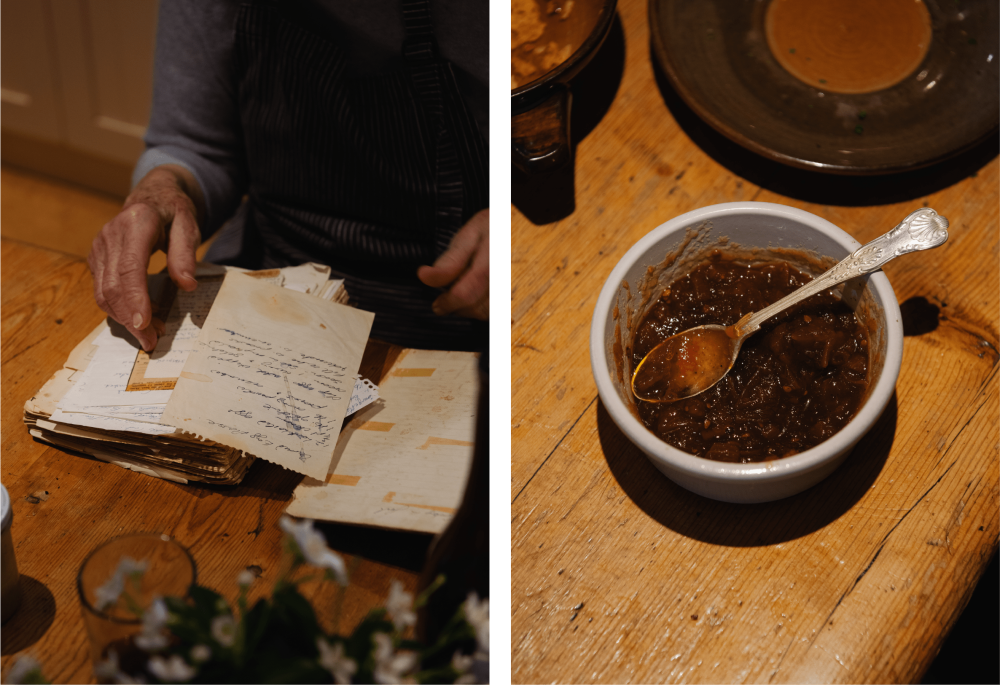Words: Charlie Monaghan
Photography: Elliot Sheppard
This Christmas season, we’re giving the gift of baking to our suppliers and partners and, in return, they are kindly sharing original festive recipes, as well as thoughts and musings on their craft that we hope you will find merry reading. First up, a visit to Lincolnshire Poacher (the dairy behind the star of our ham and cheese croissant) for leek and potato soup, cheese on toast and a chutney recipe that’s been passed down through generations.
It’s a rainy and cold winter afternoon, deep in the Lincolnshire countryside, and Jenny Jones is in her apron in her home kitchen. We’re at the farm her family has owned since 1918, and which she was born on in 1939. She is preparing, as she does every day, lunch for her two sons, Tim and Simon, who together head up Lincolnshire Poacher, a dairy best known for its cheese of the same name. Jenny is laughing, telling us how, in the first-ever edition of The Good Food Guide, published in 1951, the county of Lincolnshire was described as a ‘culinary desert’. We laugh along too because if we were to describe the sight of Jenny’s kitchen today, ‘culinary desert’ would be the last words we used.
Ok, The Good Food Guide might be focused on restaurants, but in a county like Lincolnshire, with an agricultural tradition going back millennia and which produces some 30 per cent of the UK’s fruit and veg, who needs to eat out when the best food is on the farmhouse table? Besides, “It’s like a restaurant in here,” interjects Simon when we ask what’s typically for lunch. “It could be gammon, mince on toast, a veggie curry. Yesterday we had fish pie,” says Jenny, whose timekeeping in the kitchen is set to the pace of the cheesemaking process, which happens in the dairy six days a week. “Lunchtime depends on whether the cheese is quick or slow, which essentially means the rate of acidification of the milk in the vat,” explains Simon. Cheese soufflé, Tim’s favourite, has to be very precisely timed so as not to be ready before the milling of the curd is finished, so it is saved as a once-a-month treat.
“Lunchtime depends on whether the cheese is quick or slow”
Clockwise from top left: About bread, Tim says: “There are so many similarities between sourdough fermentation and what we do.” Simon stirs the soup. Jenny Jones sits down with her sons every day for lunch, normally over the crossword – “We do the easy, not cryptic; we haven’t reached those dizzy heights yet!” Cheese on toast ready for the grill.
On the menu today is a leek, potato and onion soup – “pretty typical,” says Tim – and a quick and glorious cheese on toast made from our offering of loaves of white and dark sourdough, which Simon cuts, toasts, spreads with his proprietary whey butter, adorns with Lincolnshire Poacher and then finishes in the Aga. “I was going to sweat onions and all sorts, but that didn’t happen,” says Jenny, but Tim is quick to point out that, “All you need is good bread, good butter and good cheese, and ours happens to melt nicely.”
The suitability of Lincolnshire Poacher to some time under the grill is something not unknown to us. We began working with Tim and Simon in 2020, when we were introduced to them by our cheesemonger Rhuaridh Buchanan. We were looking for a well-melting cheese to adorn the top of our ham and cheese croissant and in Lincolnshire Poacher, which sits somewhere between a Cheddar and an ‘Alpine’ cheese like Comté, we found what we were looking for.
“All you need is good bread, good butter and good cheese”
Jenny opens up her recipe book, which she tells us is at least 60 years old. Along with the chutney recipe, there are recipes for marmalades, jams and all manner of soups.
“We embrace variation and nuance in our cheese”
But equal to the cheese itself, the brother’s approach to farming and craft was the sign that we’d found a partner aligned with our values. It was Jenny’s grandfather who took over the farm in 1918 – a family photo from that time hangs proudly in the farm office – and while cows were introduced in the 1970s, Simon got the cheesemaking going in 1992. Unlike commercial brands, Lincolnshire Poacher is made with raw milk from the farm’s herd, meaning it’s full of life and complexity. “Because we don’t pasteurise or homogenise our milk, we have a lot more opportunity to create something interesting,” explains Simon, adding, “but, on the flip side, there’s a lot more opportunity to something awful if you don’t know what you’re doing.” That’s where the cheesemaker’s skill comes in: “One of the curious things about it is that it’s creative and instinctive, but you need to get the numbers right and have attention to detail too.”
All that creates lots of nuance in the cheese, and that’s before the maturation process begins. As it sits in the store for at least 14 months, the cheese develops and gains Poacher’s signature creamy texture and flavour complexity that is impossible to predict until tasted at various stages, a job shared by Simon and Tim. “That’s why we don’t sell to supermarkets any more. They want one consistent flavour in every bite of cheese, which we can’t provide. We embrace variation and nuance in our cheese,” says Tim, just as the toast comes out of the oven.
Above: The farm and dairy office is housed in a barn that has various bricks with ‘1820’ etched into them, the year it was built. The brothers renovated the building with the help of a local builder over three years – “The repointing of the bricks took him three months alone,” says Tim. Water is left to sit on the floor of the cheese store to raise the humidity.
As we sit down to eat, a bottle of Beaujolais is opened, though the three of them are keen to stress this is not typical of a Tuesday. The food, though, is – perhaps unsurprisingly for a farming family. Simon, though, attributes a love of food among him and his siblings to the influence of Jenny, who trained at the Cordon Bleu in the early 1960s. “I worked for six pounds a week in the Cordon Bleu restaurant in Marylebone Lane after my training. It was all women, and we were treated horribly, so I left and took a secretarial job after not long!” The training, though, stuck, and home cooking is at the heart of family life here. Simon is a keen preserver, using only organic fruit and sugar in his jams and marmalade, while Tim got the sourdough bug in lockdown and hasn’t stopped. This lunchtime, the conversation turns to Tim’s vegetable patch: “Can you cook runner bean seeds fresh? I’ve never done it,” he asks, to which Jenny replies, “Only one way to find out, dear.”
Above: “It’s amazing what a difference really good bread makes,” says Simon.
With the wine poured, the soup in bowls and the cheese on toast out of the oven, a last-minute addition comes in the form of a chutney that Simon and Jenny made a batch of recently. When we ask more about it, a quiet excitement rises in the three of them and Jenny goes to her bookshelf, where she pulls out a handwritten recipe book she’s kept for 60 years and finds the page for ‘Aunt Tot’s Pickle’. “It’s not our aunt but Phoebe’s. She is a dear friend of ours, who is 85 and has worked for us for 50 years. Tim was one year old when she started,” says Simon. It’s a simple recipe but the key ingredient is time. “It needs some weeks to mature, so if you make it now it will be perfect for Christmas,” explains Simon. As with cheese, so with chutney, then – two perfectly complementary foods, the art of which lies in careful preparation, and then simply waiting for good things to come.
Aunt Tot’s Green Tomato and Apple Chutney
“When it starts plopping, give it a good 45 minutes as you want it quite thick,” says Simon.
450g green tomatoes
450g onion
450g apples
450g sugar
1 tsp salt
1 tsp pepper
1/2 tsp ground ginger
280ml malt vinegar
140ml Worcestershire sauce
Chop tomatoes, onion and apples. Boil vinegar and sugar together. Add all other ingredients, bring to a boil and then simmer for 45 minutes, or until well thickened. Stir frequently.
Pour into sterilised jars and mature for at least a couple of weeks before opening.
Lincolnshire Poacher on toast
Sourdough bread
Lincolnshire Poacher cheese
Good quality butter
Cut medium-thick slices of bread and lightly toast under the grill. Grate enough cheese to cover the toast liberally. Return to the grill. It’s ready when the cheese has melted and is lightly bubbling.
Optional: spread mustard on top of the butter before adding the cheese and douse with Worcestershire sauce when ready.
Potage Purée Bonne Femme
4 potatoes
5 leeks
40g butter
Salt and pepper
400ml milk
400ml water
Liaison
2 egg yolks
140ml single cream or top of milk
Parsley, to serve
Slice the potatoes and shred the leeks. Melt the butter in a stewpan, add the potatoes and leeks. Season with salt and pepper and stir over medium-low heat until the vegetables are nearly soft. Add the milk and water and stir until boiling. Leave to simmer for 15-20 minutes. Rub through a sieve, gradually add the yolks of egg beaten into the cream, and thicken under low heat without boiling. Serve with lots of chopped parsley.



